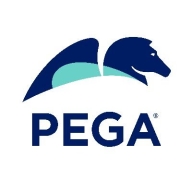

Pega Platform and SnapLogic compete in the business process management and data integration software category. Pega Platform seems to have the upper hand due to its comprehensive enterprise-level capabilities, while SnapLogic provides flexible and easy integration solutions.
Features: Pega Platform offers strengths in comprehensive BPM functionalities like case management, integration services, and a low-code environment. It is suitable for rapid deployment and complex workflows. SnapLogic excels in data integration with a low-code approach, using snaps for easy connections, and is favored for handling complex, high-volume integrations efficiently.
Room for Improvement: Pega Platform faces challenges with its UI, integration capabilities, and complexity for novice users. Users also desire improvements in cloud presence and licensing models. SnapLogic requires added user-friendly features, better support, and enhanced API management. It struggles with high-volume dataset processing and transparency in data flows.
Ease of Deployment and Customer Service: Pega Platform supports on-premises, cloud, and hybrid deployments with some flexibility. However, user feedback on customer service highlights delays and responsiveness issues. SnapLogic operates primarily in hybrid and cloud environments, providing an easy UI and good technical support, but both solutions have areas needing service improvements.
Pricing and ROI: Pega Platform is noted for its high cost with complex licensing models, targeting larger enterprises but offering substantial ROI for enterprise-level solutions. SnapLogic's pricing is reasonable, varying based on usage and integration numbers, and it offers cost-effective ROI in streamlining complex workflows.
SnapLogic is really helpful and processes in very little time, so it doesn't take much time compared to any legacy tool.
The technical support from Pega is very low, rating a one or two out of ten.
I never needed support from the platform standpoint, but if additional features are required, we have regular meetings with the product team for feedback.
Pega's technical support team is very helpful.
Some SMEs are allotted for the organization, so in case of any issue, we have their email IDs to contact them for support, including SMEs and community.
The technical support from SnapLogic is excellent, and I would give it a complete ten.
Currently, big banking providers and insurance providers, even the members for healthcare payers, are using more than millions of operations on a daily or weekly basis.
I rate the scalability of SnapLogic as eight out of ten.
But recently, in a year, I haven't found many performance issues in SnapLogic.
I would rate the stability of SnapLogic as nearly ten out of ten.
With the recent development of AI agents in Pega Platform 24.2, the adoption is not heavy due to regulations around using external LLM by customers, especially regulated customers in BFSS and healthcare.
Pega introduced Constellation, which allows a user to build a more engaging visual experience.
My learning curve in robotics has been challenging.
If the AI capabilities and integrations were more intuitive and easy to learn for new users, it would be greatly beneficial.
They can improve more visuals, with graphical representations, such as how many things can be added, how many users can be added or dropped, and how the back-end nodes can be graphically shown in a better way.
I tend to frequently communicate with SnapLogic to ask for additional features, and they have been responsive.
Pega is priced higher than open-source options like Flowable but is suitable for large-scale industries like banking and insurance.
The pricing is expensive, and this is an issue.
From a licensing perspective, it is higher than the competition.
There would be only one point of improvement if the price could be lower.
SnapLogic is positioned at around seven or eight out of ten in terms of pricing.
Management capabilities such as dashboards.
Pega Platform is excellent for enterprise-level solutions with integrations to entire systems, including case management, service orchestration, CRM, decision-making capabilities, digital process automation, and AI-driven functionalities.
I also like the whole child-parent pipeline feature; it allows me to break up a process into smaller pieces and then have one big pipeline that controls these smaller pipelines.
I find SnapLogic to be user-friendly, especially for beginners with limited experience in data engineering or ETL.
It's moving into AI, so we can create AI agents with LLM models. We can use most of the LLM such as Amazon Bedrock, OpenAI, Azure AI.
| Product | Market Share (%) |
|---|---|
| Pega Platform | 6.3% |
| SnapLogic | 0.6% |
| Other | 93.1% |


| Company Size | Count |
|---|---|
| Small Business | 9 |
| Midsize Enterprise | 15 |
| Large Enterprise | 68 |
| Company Size | Count |
|---|---|
| Small Business | 11 |
| Midsize Enterprise | 5 |
| Large Enterprise | 10 |
Pega Platform provides flexible business process management with a focus on rapid application development and automation through a low-code approach, enhancing efficiency across sectors.
Pega Platform is renowned for its ability to streamline operations with robust automation features, including robotic process automation and decision-making capabilities. Its intuitive interface and workflow management contribute to a reputation for enhancing business processes. Although users face challenges with integration limitations and high licensing costs, they benefit from rapid deployment and efficient process adaptations. The unified architecture reduces complexity, while case management and integration services support digital transformations in sectors such as banking, insurance, and healthcare.
What are the key features of Pega Platform?In industries like insurance, banking, healthcare, and government, Pega Platform is implemented to automate diverse workflows, supporting initiatives from claims processing to customer onboarding. Enterprises use Pega for case management and digital transformations, valuing its out-of-the-box integrations and real-time reporting capabilities to boost operational automation and enhance customer experiences.
The SnapLogic Intelligent Integration Platform uses AI-powered workflows to automate all stages of IT integration projects – design, development, deployment, and maintenance – whether on-premises, in the cloud, or in hybrid environments. The platform’s easy-to-use, self-service interface enables both expert and citizen integrators to manage all application integration, data integration, API management, B2B integration, and data engineering projects on a single, scalable platform. With SnapLogic, organizations can connect all of their enterprise systems quickly and easily to automate business processes, accelerate analytics, and drive transformation.
We monitor all Process Automation reviews to prevent fraudulent reviews and keep review quality high. We do not post reviews by company employees or direct competitors. We validate each review for authenticity via cross-reference with LinkedIn, and personal follow-up with the reviewer when necessary.